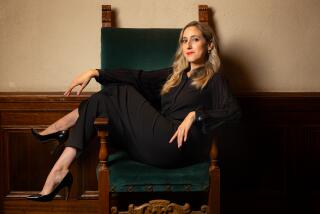DANCE REVIEWS : Polsky Premieres ‘Dreams, Prayers’ at Cal State L.A.
- Share via
Rose Polsky creates character studies in classic modern dance style about loners obsessed with the past. Her newest work frames this theme in the trappings of late-’80s movement-spectacle but without dispelling the notion that Polsky, too, is a loner best encountered in one of her sensitive, uninsistent solos.
Given its premiere at Cal State L.A. on Friday, Polsky’s “Dreams, Prayers and Fears” begins with an elaborate kinetic fanfare: hordes of dancers running, falling and sliding. Soprano Diana Zaslove appears to sing a Handelian prayer for sleep and forgetfulness after which the crowd forms a phalanx that persistently excludes or ejects Polsky.
The scene in which Polsky endures the indifferent, mocking and then malevolent group seems awfully obvious, but it does lead to a passage of purest Polsky magic: As she goes through the objects in an old suitcase, we hear whispers and then see four dancers who embody the emotions, energies and relationships defined by those objects.
Later on, people peer at her as she quietly arranges the objects on a mantle--and they continue even when she sleeps--but their actions duplicate a spoken text and don’t add anything. Only in the suitcase section has Polsky found essential roles for someone beside herself.
Music by Meredith Monk both accompanies and shapes the two solos of “Black Dress,” Polsky’s virtuosic portrait of a woman’s declining mental stability. In contrast to the wistful vivacity of the five-year-old Part I, the 1992 section features violent mood swings and grotesque reminiscences: images of being bug-infested, of digging a hole to hide in and then running away. A remarkably varied and vivid performance makes this the highlight of the program.
The first half of “Two Songs” from 1987 finds Jeremie Basmajian repeatedly uncoiling and reaching up with a kind of glowing expectation only to sink downward--human hope embodied in the simplest rising motions. Executed neatly by Carolyn Hall, “Courtship Story” from two years later provides little more than a gestural gloss on a compelling recorded interview with an 87-year-old widow. An uneven program but one with major artistic interest.
More to Read
The biggest entertainment stories
Get our big stories about Hollywood, film, television, music, arts, culture and more right in your inbox as soon as they publish.
You may occasionally receive promotional content from the Los Angeles Times.










